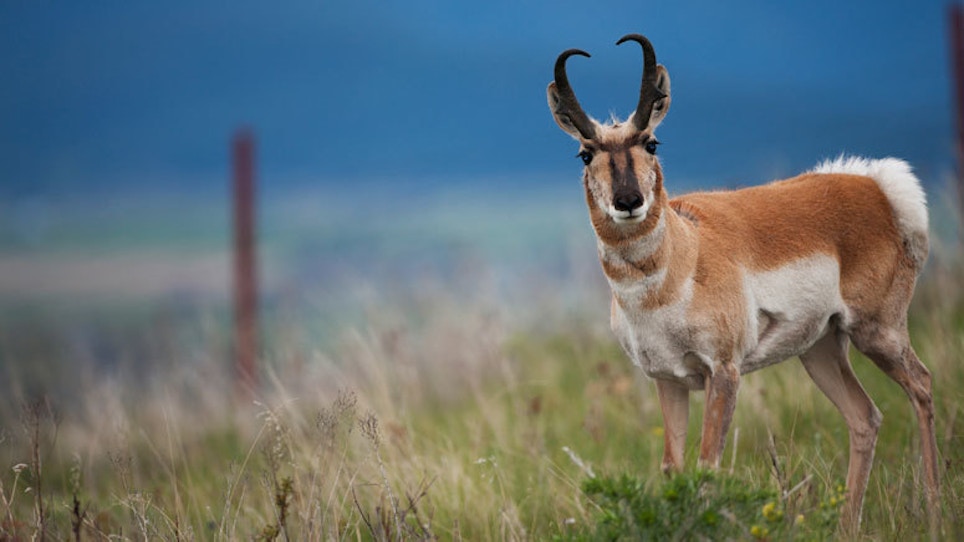Why do people insist on calling them “antelope?” Pronghorn are not related to antelope, goats or sheep, but instead are the sole remaining member of an ancient family dating back to the Pleistocene period. They are their own scientific genus and are only found in North America. Their horns are true horns, not antler, made of keratin, the same stuff that makes up your fingernails. And they are incredible.
My first archery pronghorn came in the early 1980s in western Montana on a spot-and-stalk hunt where I tried all sorts of things to get a shot. I blew exactly nine different attempts before making it happen. When it did I about peed my pants, then roared like a lion.
Did you know that an estimated 30 to 40 million pronghorn once roamed North America, a number some scientists believe is more than even the bison, whose historical numbers are legend? The arrival of the European settlers was the pronghorn’s downfall. The settlers hunted both sexes all year long with little or no restraint until the animals were completely wiped out in some areas and shot so low in others they were barely hanging on.
At the turn of the 20th century, the remnants of the once vast pronghorn herds were found only in small, isolated areas. The lowest documented number I could find comes from the annual report of the American Bison Society in 1910, which pegged the number at about 13,000.
By the 1920s the public was clamoring for action to save both the pronghorn and the other game species that had been hunted nearly to extinction by the settlers. By now no pronghorn hunting was permitted. California closed its pronghorn season in 1883. Nevada, Oregon, Montana and Oregon had done the same by 1909. The first thorough survey of pronghorn numbers in Canada, the U.S. and Mexico was conducted between 1922-24, published in 1925 by U.S. Bureau of Biological Survey (later renamed U.S. Fish & Wildlife Service) biologist Edward W. Nelson. He pegged their numbers at some 30,400 animals. To further boost pronghorn protection, the Hart Mountain National Antelope Refuge (today called Hart Mountain National Wildlife Refuge) in eastern Oregon was established on Sept. 6, 1935. On Dec. 21, 1936, the Charles Sheldon Antelope Range (later combined with another refuge to form Sheldon National Wildlife Refuge) was established in northern Nevada.
In 1968 – 52 years after Nelson’s report – the results of the next comprehensive pronghorn population survey were presented to the Pronghorn Antelope Workshop in Cheyenne, Wyoming. Based on 1964 data, it showed a population estimate of some 386,300 – an increase of over 1000 percent. In 1976, another survey was conducted, and it showed a population of some 431,600 pronghorn. In 1985, yet another survey was conducted, this time showing a population of some 1,051,500 pronghorn. In spite of increased human population, energy development and agriculture in pronghorn country, as well as controlled sport hunting, the animals had more than doubled their numbers in that decade.
I haven’t been able to track down a concrete figure showing current population numbers. However, most pronghorn whisperers have it pegged at somewhere around 750,000. Numbers – and available hunting permits – fluctuate annually, depending on how the animals survived the winter, and current predation by coyotes, eagles and other animals who love their tender flesh as much as I do.
Pronghorn are the second-fastest land animal in the world, surpassed only by the cheetah. Pronghorn have been clocked at 70 mph for up to four minutes at a time and can cruise at 30 mph, a speed they can hold for 15 miles or more. They rely primarily on this blazing speed and their extremely acute eyesight as their first line of defense against predation. It took me a while to figure out that they also have a tremendous sense of smell and will bugger off if you don’t play the wind. For years I’d make a stalk, belly-crawling to the top of the rise where I was sure I could get a shot only to find the animals long gone. “Wow!” I used to think. “How the heck did they see me?” The answer is, they didn’t have to. A snootful of my B.O. was enough.
The introduction of the high-quality pop-up blind changed the way bowhunters pursue pronghorn. Today, most archers sit in a ground blind set 15 to 30 yards from a waterhole and wait 'em out. In dry years in pronghorn country this can be extremely effective. Sudden rains that create small water sources throughout the area, however, can doom this technique to failure. The amount of water a pronghorn needs is dependent upon the availability of succulent green vegetation and season. One California study showed a daily consumption rate of 0.34 quarts/day in May and 4.8 quarts/day in August.
When the animals are rutting, using a life-sized buck decoy can often bring a territorial buck in quickly. I have seen them come running as fast as they can from half a mile, stopping in a cloud of dust anywhere from 10 to 50 yards away and staring at the intruder. Your job, of course, is to draw while hidden behind the decoy, then rise over the top and let one fly before the buck turns himself inside out to escape. The action can be fast and furious; arrows can, and do, fly anywhere and everywhere!
Like a sailor who runs to the sea, it is the rare year when I do not venture forth, bow in hand, to hunt Antilocapra americana, the all-American pronghorn. Try it just once, and you’ll know just what I mean.
I’m curious about how your 2015 pronghorn excursions go, and just what you think about the species in general. Drop me a line at brobb@grandviewmedia.com.






